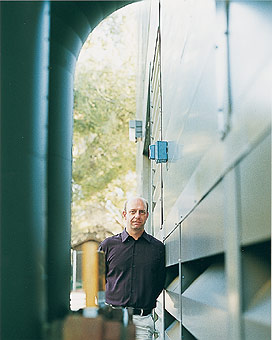The Backstory
At least that’s how it seemed to the site’s developer
By Eric Weissman |
|
|
|
Imagine this: You take on a project that has 100,000 pieces or more — no one can say for sure. You know there’s no way everyone is going to be satisfied and some actually might be upset. You have meager resources. You have other work to do. Then imagine you aggressively reel in your deadlines and recruit a cadre of diverse figures in academia — from professors to researchers to students to staffers — in a search for consensus, of all things. Are you nuts? Or are you Michael Halaas?
When Halaas, who oversees the school’s public Web site, undertook a wholesale redesign, he knew tough times lay ahead.
“Web design committees are notoriously inefficient,” he says. “It’s easy to get mired in style details and deterred from the larger mission of communicating information.”
The new site is about more than a new look. Halaas built it on a superstructure inspired by the school’s strategic plan, dividing key content areas into four categories: Education, Research, Patient Care and Community. To fill those areas with information, he brainstormed with scores of individuals and groups.
“Those sessions could be shoot-from-the-hip,” Halaas says. “We solicited ideas from as many people as possible and encouraged insane ideas in the beginning — and we got them. But everyone came with a unique perspective and that’s just what I needed.”
As late as two days before the Web site’s first 3,000-plus pages went live in early January, Halaas and his team were still at it, changing the design in response to last-minute realizations. The changes will continue as the remaining 100,000-plus pages go online.
So is Michael Halaas nuts? Lucky for us, he is.
Michael’s greatest Web hits: Web developer Michael Halaas shares some tidbits
• The address: http://med.stanford.edu
• Number of unique hits on the home page: 50,000 per month.
• Number of unique hits on any part of the site: 325,000 per month.
• Favorite site fact: It’s much more than a simple marketing site.
It’s a window into cutting-edge medical research, treatment and education.
• Best page to visit other than the home page: The "mednews" section
since it gives you a good, quick overview of what’s going on here. (Pull
down “Quick Links,” then go to “News.”)
• Behind-the-scenes hero: The invaluable Kevin Boyd, lead Web designer.
• Next biggest challenge: Launching a new faculty research directory by
May 2004.
• Best kept secret about the site: The number of people, (>130), who
contribute information daily
Comments? Contact Stanford Medicine at

